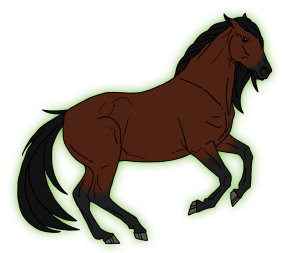Difference between revisions of "Imperial Warmblood"
RedAttendant (talk | contribs) (Created page with "thumb The imperial warmblood is the most well-rounded horse that currently exists. It was developed by crossing Wuxine Firetail|Wuxine Fireta...") |
RedAttendant (talk | contribs) m |
||
| Line 51: | Line 51: | ||
[[Category:Common]] | [[Category:Common]] | ||
[[Category:Tameable]] | [[Category:Tameable]] | ||
| + | [[Category:Passive]] | ||
Latest revision as of 01:47, 26 April 2021
The imperial warmblood is the most well-rounded horse that currently exists. It was developed by crossing Wuxine Firetails with Ajja Coldbloods, and then adding Treivan Wild Horse, giving them a variety of desired traits that allowed them to spread in their early development. They were originally bred for war, although they have surprisingly even temperaments despite their intended use.
Imperial Warmbloods are generally around 16 - 17.2 HH (162.5 - 174.7 cm, 64 - 68.8 in), and weigh in around 771.1 kilos (1700 lbs), making them the second largest breed of horse in Aversia. Their coat colors vary drastically, and they can have any colors that their ancestor breeds have--along with some pinto colors--with bay being the most common and most desirable due to its regal appearance.
Despite their breeding, and their use for war, they are actually quite docile, and an inexperienced rider can handle one without too much trouble. They are gentle-mannered and eager to please, and believed to be one of the easiest breeds of horse to train, as they respond well to most methods.
They are generally quite strong, and can make good cart horses, but their stamina has become somewhat lacking after breeding away from their ancestor breeds. They can sprint at a high speed for a short period of time, but they can't keep it up for long; this is mostly a result of them being used for war horses where an initial cavalry charge tends to not last for more than a few moments.
Only a handful of purebred Imperial Warmblood still exist in captivity, as there has been little need for war horses, and Imperial Warmbloods are notorious for eating their owners out of house and home from how much feed they require. They are often crossed with other, easier to feed horses to try and work against this. There are, however, a few scattered feral herds that are believed to still be mostly purebred, though they are few and far between.
Distribution
They found most commonly in temperate grasslands, usually within mid continent. Even the feral herds rarely travel down towards the desert, as they require a lot of food to survive, and the savannah is already home to plenty of other horses and prey animals they would have to compete with. Due to their shrinking purebred numbers, they are considered to be common, if only barely.
Habitat
In captivity, they are most often kept in stalls and pastures. In the wild, they are nomadic, and rarely stay in one place for long, even with young foals in the herd. They will often gather under trees at night to protect themselves from the elements.
Diet
Like all other horses, they are herbivores. They feed on grass, hay, grain, and whatever else they may require to maintain their weight and health. Feral Imperial Warmbloods will usually only eat grass and whatever other plants they may pick up while grazing.
Relations
Imperial Warmbloods are very docile horses and are eager to please. They respond well to their owners, and are considered to be very easy to train. Even feral horses taken from the wild become easy to handle after some time to get used to their new surroundings and the people they will be around. It is still best to work with horses either born in captivity, or younger horses that are taken from the wild.
Mechanics
- Very docile and easy to train
- Good for inexperienced riders
- High strength and high speed
- Low stamina
- Require a lot of food to survive
- Do well in most climates, but not extremes
Material Properties
- Their fur and meat are all usable, though they are rarely killed for it.
- Their tail hair can be used in string instruments as well.
Alchemical Properties
- Undiscovered; likely none.
| Geography • Races • Flora • Fauna • Stones • Metals • Cloth • Foreign Continents |
| The World of Aethius • The Multiverse of Aethier |
